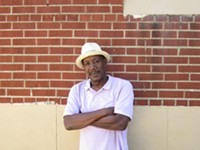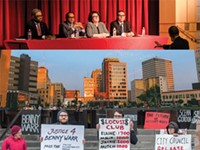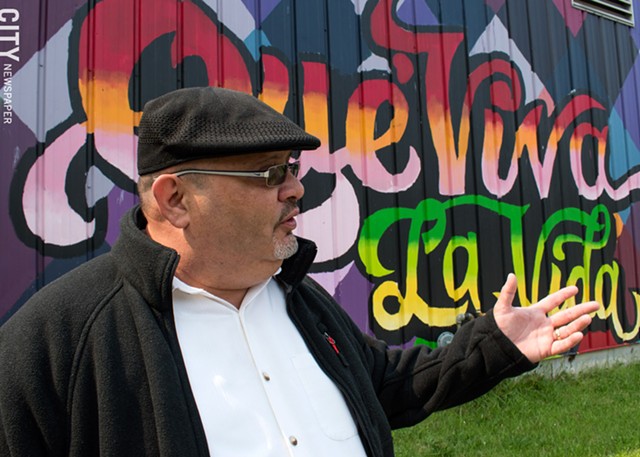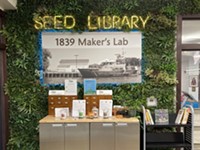[
{
"name": "500x250 Ad",
"insertPoint": "5",
"component": "15667920",
"parentWrapperClass": "",
"requiredCountToDisplay": "1"
}
]
Rochester voters will elect four key city officials this year: the people who represent the city's diverse City Council districts. But on the front lines of city life is a mosaic of neighborhood associations, block clubs, residents, business, and community institutions.
They're dealing with issues as varied as economic development, gentrification, abandoned houses, attracting young families in the neighborhood, and making sidewalks fun to walk on. And they're doing simple things like picking up litter, trimming hedges, and demanding brighter street lights. The work is a career for some; others volunteer their time.
In conversations ahead of the June 25 Democratic primary, nearly a dozen neighborhood leaders discussed the challenges their areas are facing.
SOUTH DISTRICT
City Council's South District straddles the Genesee River and encompasses the Rochester airport, the University of Rochester, Highland Park, and a diverse set of neighborhoods: Mt. Hope and the South Wedge on the east, historic Corn Hill, the 19th Ward, and PLEX on the west.
The 19th Ward, on the southern end of the district, and its neighbor Plymouth-Exchange – PLEX – are historically black neighborhoods, and for the bulk of the last few decades, poor. Today, gentrification is spreading from the South Wedge to the 19th Ward and PLEX. Extreme poverty remains, but less than a mile or two away, housing values are reaching six figures.
"We have to keep an eye on what's going on here in the 19th Ward, to make sure that families can stay here and afford here," Zola Brown says over cheesy grits and coffee at the Arnett Cafe. Brown has spent most of the last decade involved with the 19th Ward Community Association, and she became its president just a few months ago. The neighborhood, she says, is in transition.
Brown says 214 University of Rochester staff members have settled in the 19th Ward over the last five years, in part because of incentives from the University of Rochester and the city. The university and the city provide home-ownership grants for university employees in nearby South District neighborhoods, including the 19th Ward, PLEX, and the South Wedge, as well as in several east district neighborhoods.
In addition, many University of Rochester students rent in the district, and in some neighborhoods, that's become controversial. To the 19th Ward Association the UR is "an asset and not a burden in the sense of helping us out with getting folks to live in our community," Brown says. "We know there's student housing, but we pride ourselves with having families live in the neighborhood."
Her current focus, Brown says, is finding something to replace the KeyBank on Chili Avenue, which closed in April. "We're sorry, we don't need another mini-market there," Brown says. "We really want a bank so we can have a viable community and keep the assets here."
But for the most part, Brown says she's happy with the state of her neighborhood. As successes, she points to Brooks Landing, a mix of offices, eateries, and Staybridge Suites, a hotel at the corner of Brooks Avenue and Genesee Street. And she says the Community Association's united front and its close working relationship with city officials leaders is one of the reasons.
Dorian Hall, the president of the Plymouth-Exchange association, has a very different view of the path his neighborhood is on.
PLEX is a sort of boot-shaped area that extends to the Corn Hill neighborhood on the north and runs south along the banks of the Genesee River. To the east is the University of Rochester; to the west, the 19th Ward. The neighborhood and its association, Hall says, is overlooked, politically and literally.
And for PLEX residents, gentrification is a big issue. "The current state of my neighborhood is what I have witnessed happen in the South Wedge," says Hall. And, he says, it's what his parents experienced in Corn Hill, which was once a majority black neighborhood.
"We have been experiencing an influx of student housing," Hall says. And the plan isn't to include the PLEX community, he says, but to push out "the community that is currently there and bring in a different community."
"When I speak to certain people, they say: Your neighborhood is 'up and coming,'" Hall says. "What do you mean, that a neighborhood is 'up and coming?' I've been there my whole life. So to me, my neighborhood has always been a successful neighborhood. What that means is that other folk are moving in."
East of the river, Upper Mt. Hope Neighborhood Association president Bruce Mellen, who has lived in the neighborhood for nearly two decades, has a similar anxiety about college students. He's concerned his area is "losing its neighborhood feel."
"The owner-occupants are getting older," Mellen says. "They're starting to flee the neighborhood. They're moving to Florida for the winter and sometimes not coming back."
Many of the properties in his corner of the South District are zoned R1: low-density single-family homes. But that doesn't reflect reality in Upper Mt. Hope, Mellen says. Houses that were once single-family homes are now being rented, multiple students to a house, to University of Rochester students. And multiple students in a house, Mellon says, means multiple cars parking on the street or in the front or backyards.
"The fact is that we're so close to the U of R, it's a really lucrative market for those who want to come in and rent to students who are not related to each other, effectively setting up rooming houses," Mellen says.
"The students don't have a long outlook," says Mellen. "They don't have skin in the game in the properties."
The southern half of the East District – encompassing the South Wedge, Park Avenue, East Avenue, the Neighborhood of the Arts, Cobbs Hill – is a predominantly white area, and much of it is predominantly middle and upper income. It's an area with coffee shops, bars, restaurants, and in neighborhoods like Park Avenue, many young adults.
The north part of the district is more diverse. It includes Beechwood and the East Main, Mustard Atlantic (EMMA) neighborhood and the more well-off North Winton Village and Browncroft Boulevard areas.
It's also a district with a wealth of highly active neighborhood associations and block groups, addressing the specific problems of their communities.
In the district's southeast area alone, there are more than 30 of those groups, says Jesse Knoth, executive director of the Southeast Area Coalition, which works with them.
At the moment, Knoth says, many of the neighborhood groups SEAC works with are concerned about City Hall's consideration of guidelines that would set out specific criteria for organizations to be considered "official" neighborhood associations.
SEAC's activities range from a planned scattered site festival in the Neighborhood of the Arts this summer to helping establish historic districts, most recently in the Park Avenue neighborhood. Property owners in those districts can get tax credits for some property repairs.
"While overall income levels are higher in the southeast quadrant, there are still pockets of poverty," said Knoth. And, he says: "Renter levels are high, and you have a high level of turnover with those renters. So you don't have long-term residents, and that leads to lower engagement" in the community.
But Knoth also talks about the importance of another kind of engagement, the kind that governments, neighborhood groups, and individual residents can create – a built environment, for instance, that encourage biking and walking.
And he mentions projects that involve painting on streets and sidewalks – painting games like Twister or Monopoly on a sidewalk, for instance, or designs of cats playing with a string. "It encourages walking," says Knoth, "because there's stuff to look at on your journey." And, he says, "it gets kids out playing everywhere."
Play "is not something that is only incorporated on the playground," he says. "You can play while walking down the street."
NORTHEAST DISTRICT
Council's Northeast District's main thoroughfares – St. Paul Street, North Clinton Avenue, Joseph Avenue, Hudson Avenue, Portland Avenue, and North Goodman Street – stretch north from downtown Rochester past Route 104 to Irondequoit.
A pillar of the northeast area of the city since 1901 is Baden Street Settlement on North Clinton. Some current employees have been involved with the agency for half a century, offering housing, food, day care, physical and mental health care, and other services.
Asked to describe his neighborhood, Baden Street executive director Ron Thomas responds: "I can give you a number of descriptions, but it's not my descriptions that count."
"What we worry about is Zillow," says Thomas, "because I want the neighborhood to be perceived as where economic investments are good. And Zillow impacts that."
"I don't want it to be characterized as low income, downtrodden, vacant buildings," Thomas says.
Zillow, Trulia, and similar sites offer data-based snapshots of each area of a city. In the case of northeast Rochester, they paint a bleak picture: low housing values, high crime, and low-ranked schools.
There's plenty of reality to back up that data. Parts of North Clinton Avenue are known as "heroin alley," with random needles and baggies common in some front yards. Open-air drug markets thrive on some corners of Hudson and Joseph Avenues. Old buildings like the large Pulaski Library sit empty. Six years ago, the Landmark Society marked the building as one of its Five to Revive: a significant building whose future preservationists were worried about. Today, it's rotting on the corner of Hudson and Norton.
"My description of the community is much better than Zillow's description of the community," says Thomas. "I see a vibrant, supportive, connective community, that in fact, while it may be poor, the people here... we still have spirit, we still have the belief that we can do better. We still strive. We open up businesses. We do those things in the community that make the community better."
There are sprouts of hope in northeast Rochester that aren't visible to Zillow. There are few better neighborhoods in the City of Rochester to get ethnic food. Rochester General Hospital is expanding on Portland Avenue, and FIFCO, the parent company of Genesee Brewery, has invested heavily in its St. Paul Street headquarters.
Thomas points to the presence of Coca-Cola and the Monroe County Social Services Department. He's actively seeking more economic development in the area, but he's quick to separate the need for economic development from an interest in gentrification.
"There were only a very few blocks of African Americans here in the 40's," says Thomas. "In this neighborhood, when it was mixed the way it was," he says, the area was "a very vibrant neighborhood where people took care of each other. So what I look for in terms of Baden Street, in terms of Rochester, in terms of this neighborhood, I don't call 'gentrification.' I call it rebuilding a neighborhood, where there's a mix of people of all races, of all denominations, of all faiths, where we have created what the American dream is. A truly vibrant neighborhood where you have a truly integrated community."
"So my goal would be to have that happen again," says Thomas, "for Joseph Avenue to be a thriving economic engine that it was for northeast Rochester again."
NORTHWEST DISTRICT
City Council's diverse Northwest District is a mix of deep poverty and middle-class neighborhoods; beautiful scenic areas like Maplewood Park, Turning Point Park, and Holy Sepulchre Cemetery; thriving manufacturing in the Mount Read corridor, and the reimagined complex that was Kodak Park, now Eastman Business Park.
Bordered by the Genesee River on the east and the suburbs of Greece and Gates on the west, the district runs southward from the community of Charlotte, on the shores of Lake Ontario, to the JOSANA neighborhood on the south.
JOSANA is an acronym for Jay Orchard Street Area Neighborhood Association. The organization is no longer operating, but the name remains representative of the neighborhood. Behind a closed Tim Horton's, a few blocks west of the congested corner of Lyell Avenue and Mount Read Boulevard, are non-descript, sand-colored buildings filled with manufacturers. That's where Luis Aponte was waiting in a building he called a "breadbox."
Aponte chairs the Charles House Neighbors in Action organization, which incorporates the JOSANA neighborhood. ("Charles House" is short for Charles Settlement House, a human services agency.)
Not too long ago, the neighborhood was known as "ghost town," says Aponte. "It's not known as ghost town anymore."
JOSANA was a focus in Mayor Lovely Warren's State of the City address in April. During that speech, Warren praised the group for spearheading a plan to reboot the neighborhood after the death of 10-year-old Tyshaun Cauldwell in 2001.
Tyshaun was caught in the crossfire of a violent, drug-related dispute, and his death galvanized groups throughout JOSANA. His mother, Charlotte Freeman, was at the mayor's State of the City address in April and remembers the community response after Tyshaun died. "When my son was killed, everyone just came together," Freeman said. "We did marches, we did everything."
Twelve years ago, Aponte picked up the baton, and he and a group of neighbors and business owners got the city school district – in particular, School 17 – and the Campbell Street Rec Center involved in creating a master plan for the area in 2011.
The community worked for about two years developing the plan, Aponte says. And ideas came "not only from adults, not only from business owners, but from Charles Settlement House's teen group," he says.
When they asked the teenagers what they wanted, their answer was: somewhere safe to play – somewhere to dance, and to practice dance, tap, stepdance.
"They said, 'I do it at home in my room with my girlfriend," Aponte says, "and my mom says, 'You gotta stop stomping on the floor!'"
The master plan also gave parents a reason to believe their kids would be safe in the neighborhood – and a reason to get active.
And the plan has taken root, he says. Even lots of simple fixes like trimming back trees and picking up litter made a difference, he says.
"Are we a 100 percent? No," says Aponte. "Are we a lot better? Yes."
Aponte credits the dedication of members of Charles House Neighbors in Action and their relentlessness in making requests to city government, including City Council.
The group functions as a squeaky wheel, talking to Council members and anyone else who will listen, pressing city officials to keep their promises. City government, Aponte says, "starts things and they don't finish them."
City officials say 200 new homes have been built in the area in recent years. The Rochester Police Department says violent crimes and property crimes have been nearly cut in half since 2011. But, Aponte says, there's still much work left to do.
The new houses in the neighborhood wouldn't have happened without the city's help, he says, but the areas where the new houses are need new sidewalks, curbs, and LED street lights.
This is the only way to complete the JOSANA plan, Aponte says.
EDUCATION
One issue that's high on the list of concerns in all four districts is education, and the Rochester school district's impact on city neighborhoods.
Kevin Wilson is a transplant from the Utica area who moved to Rochester six years ago. He and his wife own a house in the Pocket neighborhood, between Culver and North Winton Roads in Council's South District. Their home is just down the street from East High School and a stone's throw from elementary School 28. His wife is a Rochester native who graduated from the School of the Arts. And Wilson echoes the sentiments of much of middle-class millennial Rochester: Is the city school district the best option for my child?
"I love this place," Wilson says. "I've dedicated a ton of time trying to make my neighborhood a better place, and I don't want to leave the city. And maybe we won't. Maybe we stay here. Probably will."
But, he says: "Certainly a lot of people in the neighborhood, people you talk with, Rochester residents, especially as they start raising their kids – they're getting 4, 5, 6 years old, and they ask, do we stay here? Do we put them in the Rochester City School District system, which has some serious challenges in terms of graduation rates and in some schools, violence?"
"Do we stay and do this?" says Wilson. "Is it the best thing for my child? That stinks, and it's not a fair discussion. It's not fair for the kids who don't have a choice. It's not fair for the kids who don't get the opportunity to find the best education possible, and that sometimes is not the case with the city school district."
In the Upper Mount Hope neighborhood, where an increasing number of college students are living, neighborhood association leader Bruce Mellen is focusing on a way to keep families who live there and attract new ones. He hopes to offer residents an alternative to city schools in their neighborhood.
"There are no city schools in our neighborhood," said Mellon. "We are trying to get a K-plus [kindergarten and up] charter school in our area. Because I think that will help with the neighborhood mix. Because the younger families that are starting to have kids immediately fly the neighborhood."
Talking to a parent in northeast Rochester, the question became how to help children navigate through a failing system.
"My daughter was in sixth grade at School 3," said Pam Jackson, the former director of the Activities / After-School Programs Department at Baden Street Settlement.
"It was time to move on to the next grade," said Jackson. "They notified us and said she cannot pass because she had a behavioral problem. But her grades were not down. She had C's and B's. They said she had a speech impediment. So we said, Why don't you get her some help? You're not going to keep her back for that. We fought it."
Jackson, who didn't know that the district was required to help, enrolled her daughter a private speech therapy program themselves.
"We work with the kids," Jackson said, "and we didn't even know what was available. We're middle class. We're doing OK. If we don't understand it, how do you expect someone who is overwhelmed to understand it?"
"We've got to think about the support systems that are needed for all people," Jackson said, so that the community "can begin to get the best out of our kids."
In northwest Rochester, residents are addressing several challenges related to the school district. "We're concerned about it as a whole," says Jonathan Hardin, president of the Charlotte Neighborhood Association, "because we don't have community schools in Charlotte in terms of high school. So our kids are all over the place, either at charter schools or Rochester city schools."
The association is concerned both about neighborhood students who are attending schools outside of the community and about the bused-in students. The neighborhood association has taken an increasingly active role in the former Charlotte High School, now known as the Leadership Academy for Young Men.
"Those kids come to school in our community," Hardin says. Between 8 in the morning and 5 in the afternoon, "they're residents of our community," he says.
The association "built a working relationship together," he says, and at some community events, more volunteers came from the student body than from the association itself.
Hardin says when he asked the principal what the neighborhood association could do for the school, he was told that there was a lack of parent involvement because students came from all over the city.
The school hadn't had a prom in four or five years, says Hardin, and the association is now working on a community-led prom for next school year.
"We need to give them something to look forward to," says Hardin. "Maybe that little bitty change can help you or help other students."
"We don't know what the fix is," Hardin says of the district. "All we know is that the current system that we have isn't working. It's going to take all hands on deck, communities, the mayor, City Council, the school board, anybody else we can drag into the picture, non-profits, to turn this around. We just need to start working on the same page together."
James Brown is a reporter for WXXI News.
Speaking of...
-

Highlights from an early summer primary
Jul 3, 2019 -

Tackling Rochester's affordable housing issue
Jun 26, 2019 -

A changing City Council faces major challenges
Jun 5, 2019 - More »











